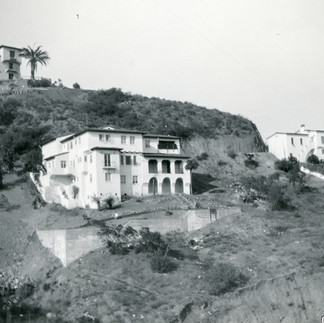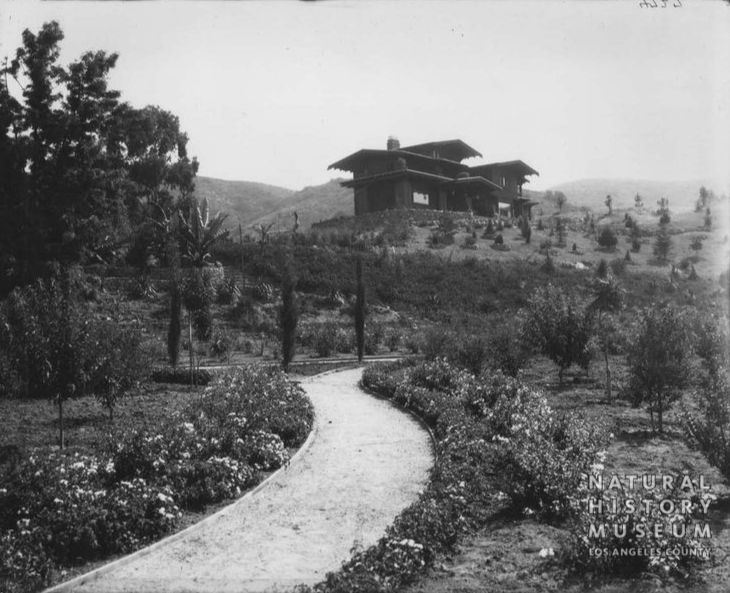Outpost Estates: Hillside Homes of Happiness
- KP
- Dec 10, 2023
- 3 min read
Updated: Jun 18, 2025
Happiness is … Outpost Estates. In the late 1920s, Charles E. Toberman promoted his new Hollywood development as “happiness for the whole family.” And it began at home in Outpost Estates, where residences combine “the charm of restfulness and rugged beauty...”

With a requirement of Mediterranean architecture, Toberman established a department to assist property owners on designing their dream home specifically for its hillside lot. An architectural jury then had to approve plans before construction could commence. Only single-family residences were permitted, excluding all businesses, apartment buildings, hotels, tenements, and boarding houses.
At the tract office on Franklin Avenue, there was plenty of inspiration: miniatures of models homes as well as free copies of “Hillside Homes of Happiness,” a pictorial booklet showing the development’s existing examples of Spanish architecture, including one of its most magnificent: 1903 Outpost Drive, owned by Dolores Del Rio. The Mexican actress—regarded as Hollywood’s first female Latin-American crossover star—autographed a limited number of booklets to boost interest in Outpost Estates.
Along the Runyon Canyon western boundary, Toberman also erected 30-foot letters spelling out “OUTPOST” that glowed in red neon on night. On the northern end, a second tract office welcomed prospective buyers up on Mulholland, an “ideal observation point for those who desire to observe the scenic advantages.”
Another innovation of Outpost Estates was its on-site nursery, where thousands of young trees—14 varieties, both domestic and imported—were planted so horticulturists could monitor which were most adaptable to the property’s soil. By 1930, an estimated 10,000 saplings had been transplanted across the 325-acre residential park already populated with live oak, sycamore, and eucalyptus.
Outpost Drive in particular was landscaped with Mediterranean carob trees to complement the architecture. In the spring, California poppy was planted throughout the tract to give it a golden background. Miniature rock gardens also sprung up as part of the beautification campaign.

Outpost Estates was named in honor of the property’s history: In 1847, General John C. Fremont selected it as his outpost from which to observe the movements of the Mexican Army. Six years later, Don Tomas Urquidez, a Spaniard, built Hollywood’s first adobe upon what is now 1851 Outpost Drive, the longtime home of The Price Is Right host Bob Barker (who had it declared a Historic-Cultural Monument in 1999).

Back in the mid-19th century, the 12-acre homestead was set in a sycamore grove—and one of its trees became infamous for being used to hang more than a dozen horse thieves. Before the turn of the 20th century, Civil War veteran General Harrison Gray Otis acquired the land after Urquidez, who was old and blind, failed to record his property title and lost ownership to settlers. Otis, also the first publisher of the Los Angeles Times, dubbed the adobe hacienda “The Outpost” and used it as a clubhouse for his military friends.
Following his death in 1917, the home and its land ended up in the hands of Louise Wooliett, president of the Hollywood School for Girls on La Brea Avenue who hoped to turn it into an artist retreat. However, in 1922 she sold it for $157,000 ($2.9 million in 2023, with inflation) to motion picture director Jesse Lasky, who intended to tear down the historic home and build his own mansion.
At the time, real estate mogul Toberman owned the 325 acres north of The Outpost, for his own residential development. But in order to get the necessary permits to subdivide the land, he needed a means of egress south to Franklin Avenue—and Lasky’s property would block that. In 1924, before the filmmaker got the chance to build upon the property, Toberman purchased the 12 acres and announced plans to subdivide it into 32 “finest” homesites.

Three years of improvements later, Outpost Estates officially opened in 1927 as a “home-builder’s Utopia.” Toberman razed the Urquidez adobe and built a showcase office at the development’s entrance along Franklin Avenue, designed by Outpost’s lead architect Rollin F. Pierson. Four decades later, as Toberman’s residential park swelled to 400-plus homes covering 1.5 square miles, the tract office was no longer necessary and torn down in 1969.









































Comments